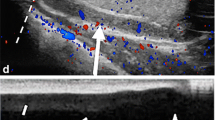Abstract
Background
Little attention has been given to the sonographic appearances of the epididymis in testicular torsion.
Objective
To describe the position and morphology of the epididymis in childhood acute testicular torsion when testicular flow is present on color Doppler sonography.
Materials and methods
We studied the sonographic findings in boys with clinically and surgically proven acute testicular torsion who were examined sonographically from May 2013 to May 2014 and who had preserved intratesticular flow on color Doppler sonography. We retrospectively evaluated the sonograms with emphasis on the epididymal findings.
Results
In all nine boys with confirmed torsion but with preserved intratesticular flow on color Doppler sonography, the epididymal head had an unexpected configuration and size, and no close relationship with the upper pole of the testis. In five of these children the spermatic cord appeared twisted on the affected side. In the remaining four boys the spermatic cord appeared straight.
Conclusion
The position and morphology of the head of the epididymis were abnormal in all boys with acute testicular torsion but with preserved testicular flow.








Similar content being viewed by others
References
Beni–Israel T, Goldman M, Bar Chaim S et al (2010) Clinical predictors for testicular torsion as seen in the pediatric ED. Am J Emerg Med 28:786–789
Gunther P, Schenk JP, Wunsch R et al (2006) Acute testicular torsion in children: the role of sonography in the diagnostic workup. Eur Radiol 16:2527–2532
Altinkilic B, Pilatz A, Weidner W (2013) Detection of normal intratesticular perfusion using color coded duplex sonography obviates need for scrotal exploration in patients with suspected testicular torsion. J Urol 189:1853–1858
Pepe P, Panella P, Pennisi M et al (2006) Does color Doppler sonography improve the clinical assessment of patients with acute scrotum? Eur J Radiol 60:120–124
Waldert M, Klatte T, Schmidbauer J et al (2010) Color Doppler sonography reliably identifies testicular torsion in boys. Urology 75:1170–1174
Karmazyn B, Steinberg R, Kornreich L et al (2005) Clinical and sonographic criteria of acute scrotum in children: a retrospective study of 172 boys. Pediatr Radiol 35:302–310
Dogra V, Gottlieb R, Oka M et al (2003) Sonography of the scrotum. Radiology 227:18–36
Arce J, Cortés M, Vargas J (2002) Sonographic diagnosis of acute spermatic cord torsion. Rotation of the cord: a key to the diagnosis. Pediatr Radiol 32:485–491
Baud C, Veyrac C, Couture A et al (1998) Spiral twist of the spermatic cord: a reliable sign of testicular torsion. Pediatr Radiol 28:950–954
Nussbaum Blask A, Rushton H (2006) Sonographic appearance of the epididymis in pediatric testicular torsion. AJR Am J Roentgenol 187:1627–1635
Leung ML, Gooding GA, Williams RD (1984) High-resolution sonography of scrotal contents in asymptomatic subjects. AJR Am J Roentgenol 143:161–164
Schalamon J, Ainoedhofer H, Schleef J et al (2006) Management of acute scrotum in children — the impact of Doppler ultrasound. J Pediatr Surg 41:1377–1380
Prando D (2009) Torsion of the spermatic cord: the main gray-scale and Doppler sonographic signs. Abdom Imaging 34:648–661
Kalfa N, Veyrac C, Lopez M et al (2007) Multicenter assessment of ultrasound of the spermatic cord in children with acute scrotum. J Urol 177:297–301
Bentley DF, Ricchiuti DJ, Nasrallah PF et al (2004) Spermatic cord torsion with preserved testis perfusion: initial anatomical observations. J Urol 172:2373–2376
Kalfa N, Veyrac C, Baud C et al (2004) Ultrasonography of the spermatic cord in children with testicular torsion: impact on the surgical strategy. J Urol 172:1692–1695
Cassar S, Bhatt S, Paltiel HJ et al (2008) Role of spectral Doppler sonography in the evaluation of partial testicular torsion. J Ultrasound Med 27:1629–1638
Conflicts of interest
None
Author information
Authors and Affiliations
Corresponding author
Rights and permissions
About this article
Cite this article
Galina, P., Dermentzoglou, V., Baltogiannis, N. et al. Sonographic appearances of the epididymis in boys with acute testicular torsion but preserved testicular blood flow on color Doppler. Pediatr Radiol 45, 1661–1671 (2015). https://doi.org/10.1007/s00247-015-3375-z
Received:
Revised:
Accepted:
Published:
Issue Date:
DOI: https://doi.org/10.1007/s00247-015-3375-z




